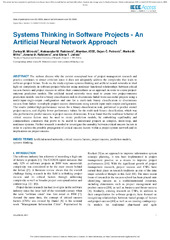Please use this identifier to cite or link to this item:
https://rfos.fon.bg.ac.rs/handle/123456789/2065Full metadata record
| DC Field | Value | Language |
|---|---|---|
| dc.creator | Mitrović, Zorica | |
| dc.creator | Rakićević, Aleksandar | |
| dc.creator | Petrović, Dejan | |
| dc.creator | Mihić, Marko | |
| dc.creator | Rakićević, Jovana | |
| dc.creator | Jelisić, Elena | |
| dc.date.accessioned | 2023-05-12T11:28:07Z | - |
| dc.date.available | 2023-05-12T11:28:07Z | - |
| dc.date.issued | 2020 | |
| dc.identifier.issn | 2169-3536 | |
| dc.identifier.uri | https://rfos.fon.bg.ac.rs/handle/123456789/2065 | - |
| dc.description.abstract | The authors discuss why the current conceptual base of project management research and practice continues to attract criticism since it does not adequately address the complexity that leads to software-project failure. To do so, the study explores systems thinking and artificial neural networks to shed light on complexity in software-project behavior using nonlinear functional relationships between critical success factors and project success to utilize their connectedness as an approach in order to create project-outcome prediction models. The artificial neural networks were used to create two project-outcome prediction models: one for a binary classification task to discriminate failed from successful projects using a multi-input-single-output configuration and one for a multi-task binary classification to discriminate success from failure in multiple project-success dimensions using a multi-input multi-output configuration. The results yielded high-performance values for a binary classification task, performed to predict overall project success, and slightly lower performance values for the multi-task binary classification, which was also performed to predict success in project-success dimensions. It was found that the nonlinear behavior of critical success factors may be used to create prediction models, by embedding equifinality and connectedness constructs that prove to be useful to understand projects as complex, multi-loop, and nonlinear systems. Further research is needed to investigate the causality between critical success factors in order to explore the possible propagation of critical success factors within a project system network and its implications on project success. | en |
| dc.publisher | IEEE-Inst Electrical Electronics Engineers Inc, Piscataway | |
| dc.rights | openAccess | |
| dc.rights.uri | https://creativecommons.org/licenses/by/4.0/ | |
| dc.source | IEEE Access | |
| dc.subject | systems thinking | en |
| dc.subject | Systems thinking | en |
| dc.subject | Stakeholders | en |
| dc.subject | Software | en |
| dc.subject | project success | en |
| dc.subject | Project management | en |
| dc.subject | Predictive models | en |
| dc.subject | prediction models | en |
| dc.subject | critical success factors | en |
| dc.subject | Complexity theory | en |
| dc.subject | Artificial neural networks | en |
| dc.subject | Artificial neural networks | en |
| dc.title | Systems Thinking in Software Projects-an Artificial Neural Network Approach | en |
| dc.type | article | |
| dc.rights.license | BY | |
| dc.citation.epage | 213635 | |
| dc.citation.other | 8: 213619-213635 | |
| dc.citation.rank | M22 | |
| dc.citation.spage | 213619 | |
| dc.citation.volume | 8 | |
| dc.identifier.doi | 10.1109/ACCESS.2020.3040169 | |
| dc.identifier.fulltext | http://prototype2.rcub.bg.ac.rs/bitstream/id/659/2061.pdf | |
| dc.identifier.rcub | conv_2426 | |
| dc.identifier.scopus | 2-s2.0-85097162026 | |
| dc.identifier.wos | 000597970800001 | |
| dc.type.version | publishedVersion | |
| item.cerifentitytype | Publications | - |
| item.fulltext | With Fulltext | - |
| item.grantfulltext | open | - |
| item.openairetype | article | - |
| item.openairecristype | http://purl.org/coar/resource_type/c_18cf | - |
| Appears in Collections: | Radovi istraživača / Researchers’ publications | |
This item is licensed under a Creative Commons License


